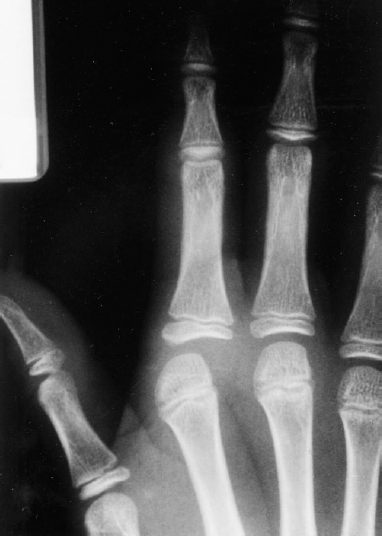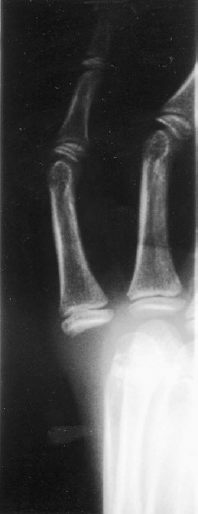49
Dorsal Metacarpophalangeal Dislocations (Irreducible)
Benjamin Chang and Mark Katz
History and Clinical Presentation
A 12-year-old boy was playing football and caught the ball on the end of his index finger. He noted immediate pain and deformity at the base of the finger and was unable to move the finger. He was brought to the emergency department on the same day for treatment.
Physical Examination
The patient’s index finger was slightly hyperextended at the metacarpophalangeal (MP) joint and flexed at the proximal interphalangeal (PIP) joint. There was no active motion at either joint. The skin was intact. The index metacarpal head was prominently palpable in the palm. Sensibility and capillary refill were normal. The remainder of the upper extremity was nontender.
Radiographic Findings
Radiographs of the hand revealed slight distraction at the MP joint and ulnar deviation of the index finger on the posteroanterior view (Fig. 49–1). The lateral view clearly demonstrates the dorsal dislocation and widened MP joint space caused by interposed soft tissue (Fig. 49–2). An oblique view was also obtained. No fractures were seen.
PEARLS
- Radiographic signs of a complex dislocation:
 Widened MP joint space interposed volar plate
Widened MP joint space interposed volar plate
 Sesamoid in MP joint space
Sesamoid in MP joint space
 Dorsal dislocation with slight hyperextension
Dorsal dislocation with slight hyperextension
- Avoid digital nerve injury by using caution on the volar skin incision or using the dorsal incision.
- Prevent misdiagnosis or delayed diagnosis by prompt radiographic examination after injury.
PITFALLS
- Traction or hyperextension during attempted closed reduction can convert a reducible dislocation into a complex one.
- Prolonged postoperative immobilization leads to stiff joints.
Differential Diagnosis
Sprain of the MP joint
Fracture of the distal metacarpal
Fracture of the proximal phalanx
Dislocation
Reducible MP joint
Irreducible MP joint
Diagnosis
Complex Dorsal Metacarpalphalangeal Dislocation
Widening of the MP joint and mild hyperextension favor a complex dorsal dislocation of the MP joint. The differential diagnosis includes subluxation of the MP joint, but the joint is usually hyperextended at 60 to 80 degrees with subluxation.
Dorsal dislocation of the MP joint usually results from a hyperextension injury. The index and small fingers are the most commonly involved digits. It is important to differentiate between subluxation and simple dislocation, which can be reduced by closed manipulation, and complex dislocation, which requires open reduction. Subluxation produces a greater dorsal angulation and should be reduced by applying pressure to the dorsal base of the proximal phalanx without longitudinal traction or forced hyperextension to re-create the mechanism of injury. A subluxation can be converted to a complex dislocation if improperly manipulated.











